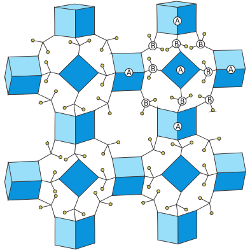Ab initio force fields from high-level reference data: application to POSiSil materials
Ab initio force fields from high-level reference data: application to POSiSil materials
Promotor(en): T. Verstraelen, V. Van Speybroeck /15_MODEV10 / Model and software developmentPOSiSils are a new type of materials currently in development at the Center of Surface Chemistry and Catalysis (COK, KU Leuven). These materials consist of silica building blocks connected by silicone linkers. The POSiSils share some similarities with zeolites and metal-organic frameworks, both nanoporous materials that receive a lot of attention in the scientific community. The most promising feature specific to POSisils is their flexibility combined with tunable hydrophobicity, rendering them ideal candidates for coatings of self-cleaning surfaces. However, the development of POSiSils is in an early stage and several steps still need to be taken in order to perfect the synthesis of these materials. This is why the Center for Molecular Modeling can offer support for our experimental partner COK (KU Leuven). By performing simulations on the atomic scale, a lot of insight in the properties of POSiSils can be gained, thus aiding the experimental development.
The most interesting features to investigate using molecular modeling, are the flexibility of the lattice and adsorption of gases in the nanopores. However, these simulations are very costly (if not impossible) at a quantum mechanical level. Classical molecular dynamics (MD) is a more attractive approach for atomic simulations that run over long length and time scales. In such simulations, the interactions between atoms are described by a force field. The accuracy of results obtained with these MD simulations depends crucially on the quality of the underlying force field. In principle, high-quality force fields can be derived from ab initio calculations such as Density Functional Theory (DFT). The main obstacle however, is that the ab initio energy has to be decomposed into parts that correspond to their force-field counterparts.

Goals The goal of this thesis is twofold. The first goal is to construct a force field that can accurately describe the flexibility of POSiSil materials. This can be done using the recently developed QuickFF methodology. However, special care needs to be taken to describe the electrostatic interactions. New models involving distributed charge densities, higher-order multipoles and novel partitioning schemes will have to be incorporated in the force field. The constructed force field can be validated by comparing with ab initio results of the perfect POSiSil lattice. Afterwards, force-field simulations on POSiSils with defects will be performed and these results will be beneficial for our experimental partner.
The second goal of this thesis is to describe the adsorption of gases in POSiSil materials. This requires a physically motivated force field that accurately describes non-bonded interactions (such as electrostatics, van der Waals, Pauli repulsion, ...) between gases and POSiSil-like materials. We have recently made progress in this research topic with a novel methodology based on the Minimal Basis Iterative Stockholder (MBIS) partitioning scheme. The methodology uses SAPT results (to ensure physical parameters) together with CCSD(T)/CBS results (to ensure accuracy). An interesting test case for this methodology is the adsorption of gases in POSiSil materials. The adsorption of guest molecules such as CO2 or H2 in nanoporous materials (such as POSiSils) has a lot of promising real-life applications such as carbon capture, hydrogen storage and gas separation.
Finally it is also important to report results to our experimental partner, and compare our simulations with their experiments. This also requires insight into experimental synthesis methods, an engineering component of this thesis. Of course the use of high-level ab initio methods combined with developing new models to describe fundamental interactions, renders this thesis ideal for students with a profound understanding of physics at the nanoscale.
- Study programmeMaster of Science in Engineering Physics [EMPHYS], Master of Science in Physics and Astronomy [CMFYST]ClustersFor Engineering Physics students, this thesis is closely related to the cluster(s) nano, modeling

